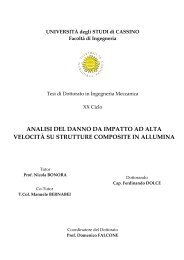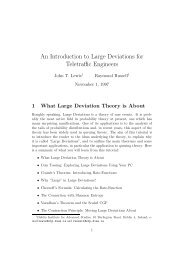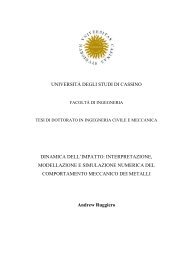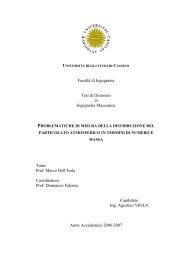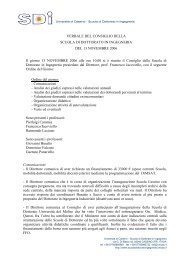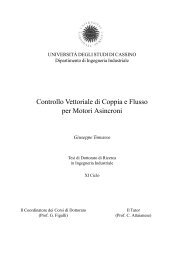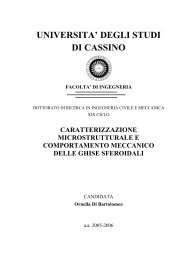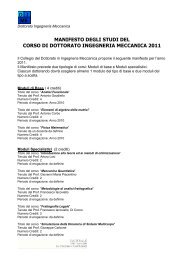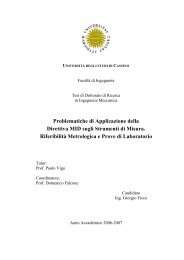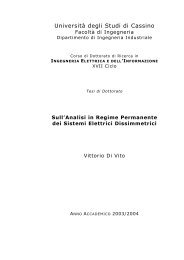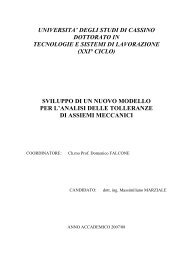Finite Strain Shape Memory Alloys Modeling - Scuola di Dottorato in ...
Finite Strain Shape Memory Alloys Modeling - Scuola di Dottorato in ...
Finite Strain Shape Memory Alloys Modeling - Scuola di Dottorato in ...
You also want an ePaper? Increase the reach of your titles
YUMPU automatically turns print PDFs into web optimized ePapers that Google loves.
It is <strong>in</strong>terest<strong>in</strong>g to evaluate how many experimental tests are necessary to completelyidentify the constitutive model parameters with a sufficient degree of accuracy:Two loa<strong>di</strong>ng and unloa<strong>di</strong>ng tensile and compressive uniaxial tests should beperformed at two <strong>di</strong>fferent high enough temperature values <strong>in</strong> order to assess theposition of the phase transformation straight l<strong>in</strong>es which def<strong>in</strong>e the start<strong>in</strong>g and thef<strong>in</strong>ish<strong>in</strong>g of the austenite to s<strong>in</strong>gle variant martensite and of the reverse transitions.Consider<strong>in</strong>g the results of these tests <strong>in</strong> terms of stress-stra<strong>in</strong>, the po<strong>in</strong>tscorrespon<strong>di</strong>ng to the start<strong>in</strong>g and the f<strong>in</strong>ish<strong>in</strong>g of the phase transition at the two<strong>di</strong>fferent temperatures can be def<strong>in</strong>ed <strong>in</strong> the <strong>di</strong>agram σ − T . In this way the straightl<strong>in</strong>es def<strong>in</strong><strong>in</strong>g the forward and the reverse phase transformation can be obta<strong>in</strong>ed.These l<strong>in</strong>es have a slope which is l<strong>in</strong>ked, <strong>in</strong> tension, to the model parameter βt. Inparticular, if p represents the slope of these l<strong>in</strong>es it can be po<strong>in</strong>ted out that:2βt= p(7.29)3The same result can be obta<strong>in</strong>ed <strong>in</strong> compression.The material constant ε Lcan be easily derived from a uniaxial loa<strong>di</strong>ng-unloa<strong>di</strong>ngtest estimat<strong>in</strong>g the maximum <strong>in</strong>elastic stra<strong>in</strong> atta<strong>in</strong>ed <strong>in</strong> the case of elastic unloa<strong>di</strong>ngwhen the material is fully martensite.Furthermore, the l<strong>in</strong>es correspon<strong>di</strong>ng to the start and the end of the A→ S and of theS→ A transitions are far from each other of a quantity equal to 3 hε 2L, so thatalso the parameter h can be evaluated.The l<strong>in</strong>es correspon<strong>di</strong>ng to the s<strong>in</strong>gle variant martensite to austenite transition crossthe temperature axis <strong>in</strong> two po<strong>in</strong>ts <strong>in</strong><strong>di</strong>cat<strong>in</strong>g the two characteristic temperaturesAsandAf. For temperature aboveAfthe pseudo-elasticity range occurs: at the end ofeach loa<strong>di</strong>ng-unloa<strong>di</strong>ng cycle the material recovers all the deformation, and the123



